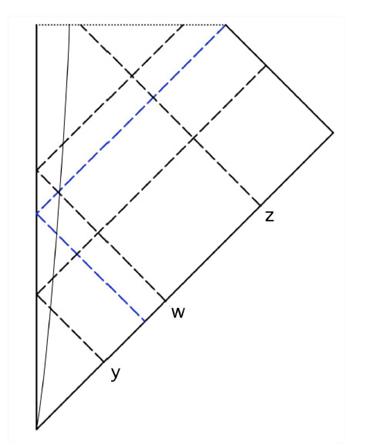Why Space Isn’t Filled with White Holes
Black holes are among the most exotic of astrophysical objects and consequently one of the most deeply studied. White holes, on the other hand, are largely ignored by astrophysicists. So it’s time, therefore, to change the balance with some deeper theoretical development of the properties of these objects, says Stephen Hsu at the University of Oregon in Eugene.

White holes are closely linked with black holes, being their time-reversed equivalent. The thinking is that whatever black holes can do, white holes also do in reverse.
That leads to an odd conclusion. In the 1970s, Stephen Hawking showed that in certain circumstances black and white holes become identical. When they are in thermal equilibrium with their surroundings, he said, they ought to absorb and emit the same amount of radiation and therefore be indistinguishable.
But what of black and white holes in other circumstances? Nobody has been quite sure, until now. Hsu tackles this question by examining how white holes would behave in isolation, surrounded by empty vacuum.
He points out that the time reversal symmetry of black and white holes only works when they are in equilibrium with their surroundings. But when they are in isolation, they are not in equilibrium. In this case, a black hole emits radiation in the form of hawking radiation. However, the white hole does not behave in a time reversed fashion; it does not absorb any radiation because it is isolated in space.
So the black hole gradually evaporates as it emits Hawking radiation, but the white hole cannot perform the time reversed operation which would be to absorb radiation because there is none to absorb. Instead, it is forced to explode, releasing large amounts of thermal energy, concludes Hsu. “Isolated white holes explode into quasithermal radiation,” he says.
he also says that while it is possible to construct an eternal black hole that lasts forever (as long as it isn’t disturbed), a similar state does not appear to be possible to white holes.
Which may mean that stable white holes cannot exist in empty space. A conclusion that appears to be backed up by the fact that a white hole or anything like has never been spotted in space.
Ref: arxiv.org/abs/1007.2934 : White Holes And Eternal Black Holes
Keep Reading
Most Popular
Large language models can do jaw-dropping things. But nobody knows exactly why.
And that's a problem. Figuring it out is one of the biggest scientific puzzles of our time and a crucial step towards controlling more powerful future models.
How scientists traced a mysterious covid case back to six toilets
When wastewater surveillance turns into a hunt for a single infected individual, the ethics get tricky.
The problem with plug-in hybrids? Their drivers.
Plug-in hybrids are often sold as a transition to EVs, but new data from Europe shows we’re still underestimating the emissions they produce.
Stay connected
Get the latest updates from
MIT Technology Review
Discover special offers, top stories, upcoming events, and more.